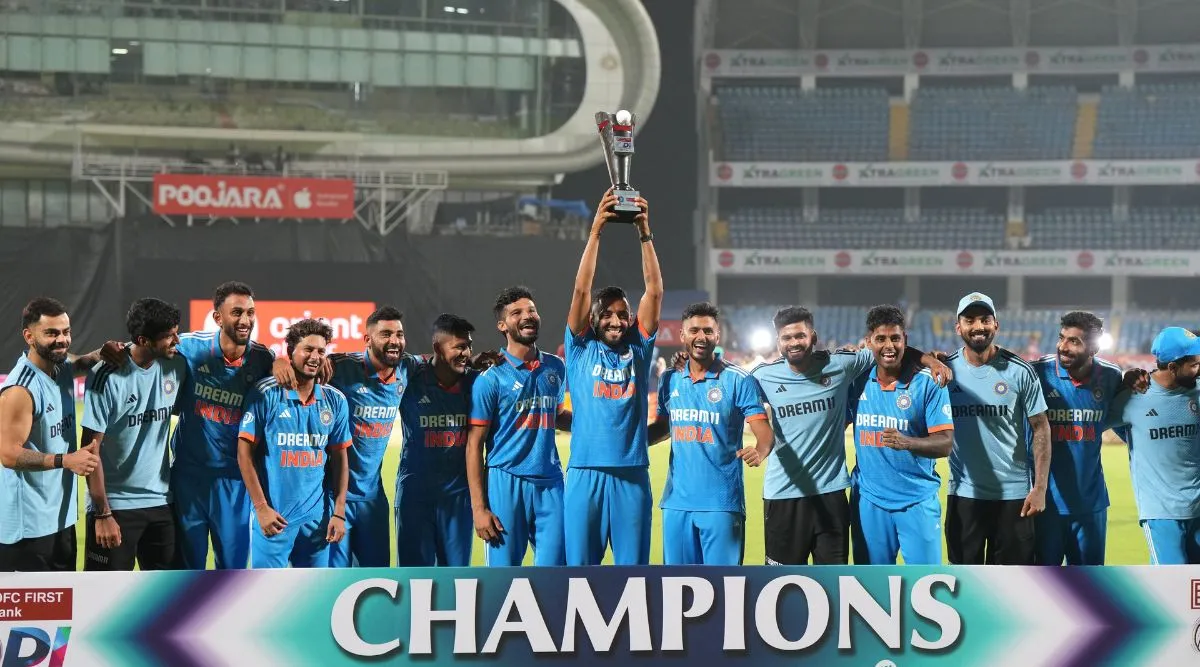australian men’s cricket team vs india national cricket team match scorecard: A Detailed Breakdown
1. Introduction: The Historic Rivalry Between Australia and India
The Australia men’s cricket team and the India national cricket team have a australian men’s cricket team vs india national cricket team match scorecard rivalry that dates back decades, one that has become one of the most thrilling and celebrated in the cricket world. From test matches to ODIs and T20s, each encounter between these two teams is filled with drama, passion, and world-class cricketing moments. Whether it’s battling for the Border-Gavaskar Trophy or meeting in World Cup fixtures, the matches are never short of excitement.
Cricket, being more than just a game in both nations, makes this rivalry intense. Australia, with its rich history of dominance in the sport, and India, with its cricket-crazy fanbase and emerging talent pool, create the perfect recipe for a fierce competition. Fans from both countries don’t just look for wins; they want their team to outperform the other in every aspect of the game – be it batting, bowling, or fielding. This intense rivalry is often the subject of heated debates and passionate discussions across social media and cricket forums.
In terms of statistics, both teams have shared their fair share of victories and defeats, and over the years, many iconic moments have defined this rivalry. From India’s famous 2001 Kolkata Test victory to Australia’s dominance during the late 90s and early 2000s, every series is etched into the history books.
2. Overview of Recent Encounters
In recent years, the battles between Australia and India have been closer and more thrilling than ever. Whether it’s the white-ball format or the red-ball test matches, these teams consistently push each other to the limit. Notably, India’s recent success in Australia – including back-to-back test series wins Down Under in 2018-19 and 2020-21 – has added another layer of intensity to the rivalry.
The most recent encounters have seen India assert dominance in test matches while Australia continues to be a force in limited-overs formats. In the 2020-21 Border-Gavaskar Trophy, India famously won the series 2-1, despite being bowled out for a historic low of 36 in the first test. Australia bounced back with their aggressive cricket in the white-ball series, with players like Steve Smith and David Warner being instrumental in their victories.
In the limited-overs format, particularly in ODIs and T20s, the margins of victory have been razor-thin. The competitiveness between the two sides is reflected in the way games swing back and forth, with individual brilliance often deciding the outcome. These encounters are a testament to the depth of talent in both squads and the tactical acumen of their coaching staff.
3. Breaking Down a Recent Match: Australia vs India
Let’s take a look at one of the most recent Australia vs India matches, which took place during the 2023 ODI series. The match, held at the Melbourne Cricket Ground (MCG), was a gripping contest that highlighted the strengths and vulnerabilities of both teams. Australia won the toss and chose to bat first, setting the stage for a fierce battle.
Australia’s top order had a strong start with David Warner and Travis Head putting up a solid partnership. Warner’s aggressive style, combined with Head’s ability to rotate the strike, put India’s bowlers under pressure. However, Indian pacer Jasprit Bumrah soon found his rhythm, breaking the partnership with a well-directed yorker to dismiss Warner.
After Warner’s dismissal, Australia struggled to maintain momentum as India’s bowlers, led by Bumrah and Mohammed Siraj, tightened their grip. Wickets fell at regular intervals, and Australia was restricted to a score that, while competitive, didn’t quite feel dominant.
India’s chase began cautiously. The Australian bowlers, particularly Mitchell Starc and Josh Hazlewood, bowled tight lines and made early inroads into India’s batting lineup. However, Shubman Gill and Virat Kohli stabilized the innings with a crucial partnership. Kohli, as always, was the backbone of India’s batting effort, playing with grace under pressure. A few late blows from India’s lower order brought them close to the target, but the match went down to the wire.
4. Australia’s Batting Performance: Key Insights
Australia’s batting lineup is known for its aggressive and attacking style, which was on full display in this match. David Warner’s role at the top of the order is crucial, as his ability to take the attack to the bowlers often sets the tone for the innings. In this particular match, Warner’s early aggression helped Australia get off to a flying start, but his dismissal changed the course of the innings.
Travis Head, another key player for Australia, showed his versatility in rotating the strike and finding boundaries when needed. However, the middle order, including Steve Smith and Marnus Labuschagne, struggled to build on the strong start. India’s bowlers exploited their weaknesses, particularly against spin, where Ravindra Jadeja and Kuldeep Yadav made scoring difficult.
A recurring issue for Australia in this match was the lack of big partnerships. While there were contributions from most of their batsmen, no one could anchor the innings after Warner’s dismissal. This left Australia with a total that, while respectable, was not as imposing as they would have liked. The middle and lower order’s inability to handle the pressure of Indian spin further exacerbated their struggle.
5. India’s Bowling Attack: A Tactical Overview
India’s bowling attack has been one of their greatest assets in recent years, and this match was no different. Jasprit Bumrah, arguably the best fast bowler in the world, led the attack with his trademark accuracy and lethal yorkers. His ability to bowl in the powerplay and at the death makes him invaluable to India’s strategy. In this match, Bumrah’s early breakthrough, dismissing Warner, shifted the momentum in India’s favor.
Mohammed Siraj and Shardul Thakur provided excellent support to Bumrah, keeping the Australian batsmen in check during the middle overs. Siraj’s ability to generate bounce and movement off the pitch troubled Australia’s top order, while Thakur’s knack for picking up wickets at crucial moments added to Australia’s woes.
The spinners, Ravindra Jadeja and Kuldeep Yadav, were the unsung heroes of the match. Jadeja’s tight bowling strangled the Australian batsmen, while Kuldeep’s variations created uncertainty in their minds. The spin duo’s ability to control the flow of runs in the middle overs was key to India’s success, especially in preventing Australia from capitalizing on their strong start.
6. India’s Batting Response: The Key Contributors
India’s response to Australia’s total was measured and strategic. Shubman Gill, opening the innings, played with composure and aggression when required. His partnership with Virat Kohli was the foundation upon which India built their chase. Gill’s ability to find gaps and keep the scoreboard ticking was crucial in neutralizing Australia’s early breakthroughs.
Kohli, often referred to as the ‘chase master’, once again proved why he’s considered one of the greatest batsmen in modern cricket. His innings was a masterclass in pacing a chase, rotating the strike, and keeping the pressure on the opposition. Kohli’s partnership with KL Rahul was another significant phase in India’s innings, as they absorbed pressure from Australia’s bowlers and kept the chase alive.
The lower middle order, particularly Hardik Pandya and Ravindra Jadeja, also played their roles to perfection. While Pandya’s big-hitting skills are well known, in this match, he showcased his ability to play a restrained and calculated innings when required. Jadeja’s all-round contribution – both with bat and ball – further emphasized his value to the Indian team.
7. Australia’s Bowling Attack: How They Matched Up Against India
Australia’s bowling attack is one of the most feared in world cricket, and this match provided a great example of why. Mitchell Starc, with his left-arm pace and ability to swing the ball, is always a threat, especially in limited-overs cricket. In this match, Starc’s early breakthroughs put India on the back foot, but his inability to strike in the middle overs allowed India to claw their way back into the game.
Josh Hazlewood’s accuracy and ability to extract bounce from the pitch made life difficult for the Indian batsmen, particularly in the early overs. Hazlewood’s disciplined line and length, coupled with Pat Cummins’ express pace, kept India’s top order in check. However, Australia’s failure to capitalize on early breakthroughs and break the Kohli-Gill partnership ultimately hurt them.
Australia’s spin attack, led by Adam Zampa, couldn’t exert the same level of control as India’s spinners. Zampa, known for his wicket-taking ability in the middle overs, struggled to contain the Indian batsmen. This allowed India to keep the required run rate within reach, and by the time Australia’s pacers returned for the final overs, the game was evenly poised.
8. Turning Points of the Match
Every cricket match has its turning points, and this clash between Australia and India was no different. One of the key moments was Jasprit Bumrah’s early dismissal of David Warner. Warner, who was looking dangerous, could have easily taken the game away from India had he stayed longer at the crease. Bumrah’s wicket not only removed a key player but also disrupted Australia’s momentum.
Another turning point was the partnership between Virat Kohli and Shubman Gill. At a time when India’s chase was faltering, this partnership stabilized the innings and ensured that India stayed within striking distance of the target. Kohli’s calmness under pressure and Gill’s attacking intent made it difficult for Australia to break through.
Finally, the death overs played by Hardik Pandya and Ravindra Jadeja proved to be crucial. With the game hanging in the balance, both players held their nerves and rotated the strike, ensuring that India got closer to the target without taking unnecessary risks.
9. Man of the Match Performance
The Man of the Match award went to Virat Kohli, whose masterful innings anchored India’s chase. Kohli’s ability to absorb pressure and accelerate when needed was on full display, reminding the cricketing world of his unparalleled skill in run chases. His knock was not only crucial in terms of runs but also in the psychological advantage it gave India over Australia.
Kohli’s understanding of the game situation, his ability to read the bowlers, and his partnership with Shubman Gill were all pivotal in guiding India to victory. Kohli’s innings will go down as one of his many great performances in what has been an illustrious career.
10. Captaincy: Leadership Under Pressure

The captaincy of both teams was tested under pressure in this match. Pat Cummins, Australia’s captain, faced a tough task after India’s strong middle-order performance. While his field placements and bowling changes were mostly on point, Cummins perhaps missed a trick by not bringing back Mitchell Starc earlier during Kohli’s partnership with Gill.
On the other hand, India’s captain, Rohit Sharma, displayed a calm and composed demeanor throughout the game. His decision to persist with Jasprit Bumrah in the powerplay paid off, and his handling of the spinners during the middle overs stifled Australia’s scoring. Sharma’s cool-headed leadership was a key factor in India’s ability to weather the early storm and emerge victorious.
11. Fielding Excellence: How Both Teams Saved and Lost Runs
Fielding is often the difference between winning and losing in modern-day cricket, and this match saw some stellar efforts from both sides. Australia, traditionally one of the best fielding sides, showed their mettle with some stunning catches and athletic saves in the outfield. Marnus Labuschagne, in particular, was a livewire, cutting off potential boundaries and saving crucial runs.
India’s fielding was equally impressive. Ravindra Jadeja, often referred to as the best fielder in the world, showcased his sharp reflexes with a brilliant run-out that swung the momentum in India’s favor. Jadeja’s ability to stop runs in the field and create wicket-taking opportunities is one of the reasons why India is such a well-rounded unit.
However, there were moments where both teams let themselves down. A couple of dropped catches by Australia at key moments allowed India to stay in the game, while India’s misfields in the outfield gifted Australia a few extra runs. In such closely contested matches, these lapses can make all the difference.
12. The Role of Spinners in Australia vs India Matches
Spin bowling has always played a significant role in the matches between Australia and India, and this encounter was no exception. India’s spinners, Ravindra Jadeja and Kuldeep Yadav, were instrumental in applying pressure on Australia’s batsmen during the middle overs. Jadeja’s ability to bowl tight lines and restrict runs, combined with Kuldeep’s knack for picking up wickets with his variations, made life difficult for the Australian batsmen.
On the Australian side, Adam Zampa was the key spinner. However, unlike India’s spinners, Zampa struggled to contain India’s batsmen. This highlighted a recurring issue for Australia – their inability to dominate India in spin-friendly conditions. While Zampa has had success in the past, this match showed that Australia still has some work to do when it comes to mastering the art of spin.
13. Pressure Situations: How Both Teams Handled It
Handling pressure is a hallmark of great cricket teams, and in this match, both Australia and India had their moments. Australia, after losing early wickets, managed to recover thanks to some composed batting in the middle overs. However, as India’s bowlers tightened the screws, the pressure started to tell, and Australia lost wickets at regular intervals.
India, on the other hand, showed remarkable composure during their chase. Even when Australia’s bowlers were on top, Kohli and Gill kept their cool and absorbed the pressure. This ability to stay calm under fire is what separates great teams from the rest, and in this case, it was India’s superior temperament that won them the match.
14. Comparing the Current Squads: Strengths and Weaknesses
When comparing the current squads of Australia and India, it’s clear that both teams have their strengths and weaknesses. Australia’s batting lineup, with players like David Warner, Steve Smith, and Marnus Labuschagne, is world-class. Their bowling attack, led by Mitchell Starc, Pat Cummins, and Josh Hazlewood, is equally formidable. However, their middle-order fragility and occasional struggles against spin remain areas of concern.
India, on the other hand, boasts a balanced squad with a strong batting lineup and a potent bowling attack. Virat Kohli, Rohit Sharma, and Shubman Gill provide solidity at the top, while the likes of Hardik Pandya and Ravindra Jadeja offer all-round capabilities. India’s spin attack, with Jadeja and Kuldeep Yadav, gives them an edge in conditions that favor spin.
The key weakness for India remains their tendency to collapse under pressure in critical moments, especially when chasing large totals. However, as seen in this match, India’s ability to adapt and find ways to win is what makes them such a formidable opponent.
15. The Importance of India vs Australia Matches in Global Cricket
Matches between Australia and India are more than just cricket games – they are cultural events that captivate millions of fans around the world. The intense rivalry, coupled with the quality of cricket on display, makes these matches some of the most-watched and discussed events in global sports. The importance of these matches extends beyond just the results; they shape the careers of players and influence the direction of the sport.
For both nations, victories in these contests carry significant weight. For India, beating Australia, especially on their home turf, is a sign of their rise as a cricketing superpower. For Australia, victories over India reaffirm their dominance in the sport. These matches also play a key role in determining ICC rankings, and often have a major impact on the teams’ preparations for global tournaments like the World Cup.
Conclusion
The rivalry between the Australia men’s cricket team and the India national cricket team continues to captivate the cricketing world. Every match is a showcase of skill, strategy, and mental toughness, with players from both sides rising to the occasion. As we’ve seen in this detailed breakdown of their recent encounter, cricket fans are treated to thrilling contests that go down to the wire, with no shortage of standout performances and turning points. Whether it’s in test matches or limited-overs cricket, the battle between these two cricketing powerhouses is sure to continue being one of the most exciting rivalries in world sport.
australian men’s cricket team vs india national cricket team match scorecard






Post Comment